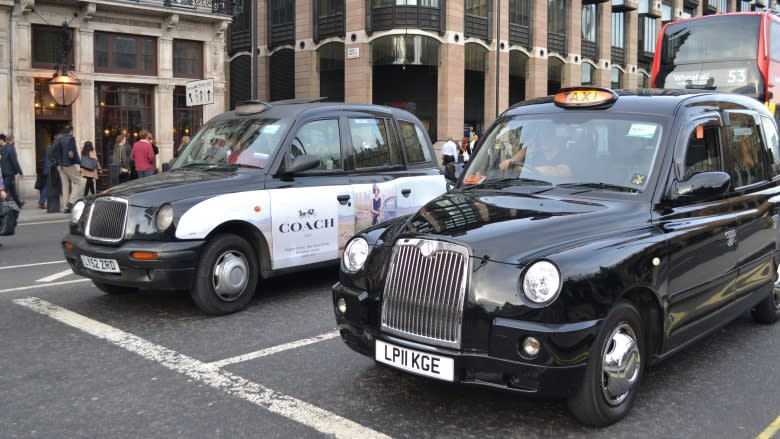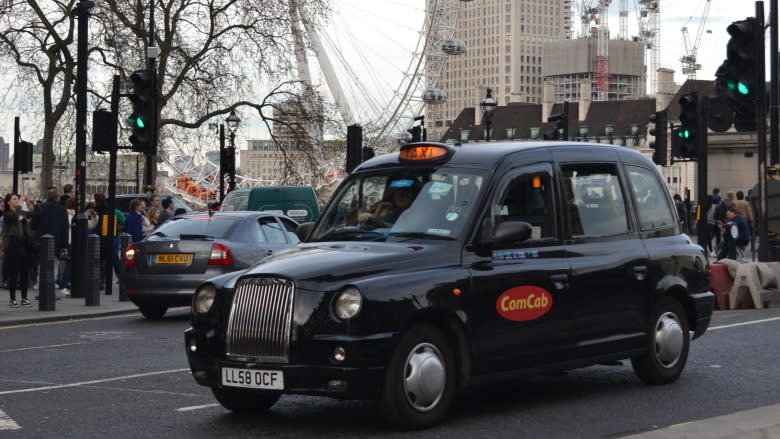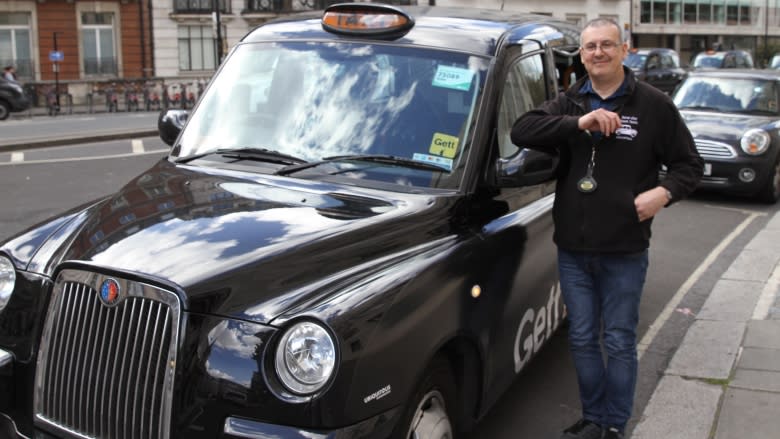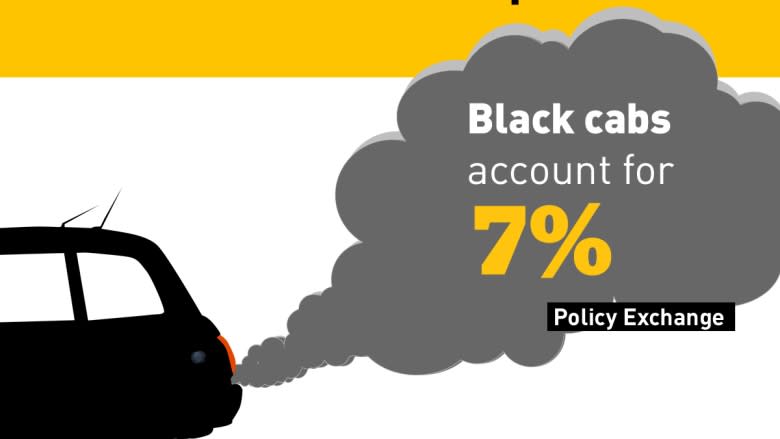Farewell to the belching black cab: Electric taxis coming to London
Aziz Traidia was flipping through his licensing papers as he sat in his taxi at a cab stand along London's Oxford Street.
The taxi driver has owned six of the British capital's iconic black cabs in his 26-year career, but his current taxi has caused him the greatest amount of grief, most recently costing him more than £1,000 for engine repairs.
"Now I've decided this is the last one. I'd never ever, ever buy a new cab except if it's the electric one that's coming, if it's nice and it's comfortable."
Luckily for Traidia, London's new electric cabs are due to hit the streets in 2018 as part of a plan to help clear the city's air of pollutants linked to increased deaths and illnesses.
Transport for London, the municipal department that runs the city's transportation system, will be replacing its diesel-reliant black cabs with zero-emission, no-noise taxis. They'll still be black, to preserve as much as possible the iconic look, but the noise and exhaust of the current vehicles will be gone.
The goal is to meet air pollution limits set by the World Health Organization and the European Union.
Just five days into 2017, London had already broken the city's air pollution limits for the year.
Pollutants linked to increased deaths
Road transport contributed close to 48 per cent of London's nitrogen oxide emissions and the soot-like particulate matter 10 (PM10) in 2010, according to a study by U.K. think-tank Policy Exchange.
London's 21,500 diesel-fuelled black cabs contributed seven per cent of the nitrogen oxide emissions.
Aaron Kiely, a campaigner at Friends of the Earth, says that the new zero emissions-capable black cabs are a "welcome change" to London.
"Taxi drivers are welcoming them is because they're aware. They're the ones sitting in London's really filthy roads, polluting the roads for most of the day," said Kiely. "It's actually the people who are inside of these vehicles [who] can be exposed to a lot higher levels of pollution than people who are walking outside or cycling outside."
Nitrogen dioxide and PM10 are both linked to increased deaths from heart and lung diseases and respiratory illness, costing London up to 9,400 early deaths and up to £3.7 billion for health care in 2010, according to U.K. think-tank Institute for Public Policy Research.
London's former mayor, Boris Johnson, began a crackdown on diesel vehicles in 2014 after the British government was successfully sued by the European Commission for breaching air pollution limits in 18 cities across the U.K., including the capital.
The crackdown affected more than one-third of all vehicles whose drivers were misled into buying diesel cars in the early 2000s through tax incentives in a government attempt to lower carbon dioxide emissions made by petrol vehicles.
The so-called Diesel Decade boosted the number of diesel-fuelled vehicles from 1.6 million in 2001 to more than 11 million on U.K. roads in 2015, when former science minister Paul Drayson admitted that the Labour government's support for diesel cars was a mistake.
According to a report by King's College London, bringing the number of diesel vehicles in the centre of London down to five per cent and increasing cleaner alternatives for vehicles would bring nearly all of London into compliance with legal levels of nitrogen dioxide.
"What we're trying to do now is unwind that dieselization, but at the same time, we don't want people to rush back to petrol vehicles,"said Sam Longman, Transport for London's policy manager for the environment. "We actually want them to get into hybrid and zero-emission vehicles, which is where that taxi policy comes in."
'Not got better'
The EU air pollution rules state that nitrogen dioxide (NO2) levels can only surpass 200 micrograms per cubic metre of air during a one-hour period 18 times per year. The WHO's guidelines are stricter, legislating that NO2 levels must remain below 40 micrograms per cubic metre of air in a one-hour period.
Nitrogen dioxide, a reddish-brown gas, combined with other pollutants like PM10s from diesel vehicles, can cause smog, which can obscure the top of London's tallest landmarks like the London Eye or Big Ben.
According to Kiely, when pollution levels are exceptionally high, the city is covered in an orange haze, though he has never seen it.
"What we see in London is the concentration of nitrogen dioxide has not improved over the last 15 to 20 years. They've not got any worse, but they've not got better," said Richard Howard, Policy Exchange's head of environmental and energy.
Since 2000, nitrogen dioxide levels have remained stubbornly above the WHO's legal limit. The soot-like PM10 levels have dropped by 24 per cent since the turn of the millennium, according to a report by the Department for Environmental, Food and Rural Affairs
Pollution 'you can see'
Howard said this is because the diesel industry has found ways to clean up the particulates from exhaust emissions through filters.
"If you blow your nose, or something like that, you can see that there is pollution," he said.
"You could see soot on the buildings and stuff like that as well. It is there. It's less visible that the really, really bad pollution that existed in London in 1950s and 1960s where you could literally see it very, very clearly in the Great Smog."
The Great Smog of 1952 killed about 4,000 people in London, but it wasn't the first time the city had been challenged by air pollution.
Fumes from coal burning in London led to the world's first air pollution commission in 1285. King Edward I outlawed the practice, but when wood from forests around London became increasingly scarce, households returned to coal for heating and cooking.
Although the nature of the capital's air pollution problem has changed from coal emissions to nitrogen dioxide, there has been an increasing focus on clearing the air by successive mayors.
New charge
Johnson introduced the low emission zone, which penalizes high polluting vehicles driving in central London, in 2012.
To further push drivers toward electric vehicles, current Mayor Sadiq Khan is extending Johnson's ultra low emission zone. By 2020, small non-compliant emission vehicles will be charged £12.50 to drive in the city centre and non-complaint trucks will be charged charged £100.
Taxi driver Stanley Andrews said he's waiting to see how the new taxis run and for his three-year warranty to run out on his 18-month-old cab. Until then, he's going to hold off on switching over to the zero-emission model.
"Fortunately, I'm in a position where I've got my own driveway. At night time, I'll be able to plug my taxi in and charge it overnight, which obviously [some drivers who ] live in London don't have that option, so it could potentially lower my running costs quite a lot," said Andrews.
He recently had a quote done for retrofitting his home in Crawley, ust south of London, for solar panels to counteract an increase in electricity if he decides to go for the rechargeable zero-emission taxi.
As for Traidia, he's looking forward to getting rid of his problem-riddled diesel taxi in favour of the new electric model, even though he plans to retire in five to six years.
"I would go for electric because definitely it's not going to be a problem mechanically. Even though I don't know [what the new engine will be like], it's not going to be like this one," said Traidia. "It's a bad engine. The rattling, the noise, they're not good taxis."










